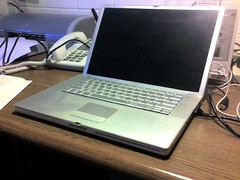Every once in a while, I’ll grab and old issue of WIRED Magazine and thumb through just to gander at what got our attention only five or eight years ago, what cell phones were hot, how much memory we lusted for, and even a few ads for Apple Newton PDAs.
Yesterday I reached back only a year and a half to be reminded of an article that I merely mentioned, then, in this blog. It concerned IQ tests, and evidence that we are getting smarter. U.S. born, New Zealand philosophy professor, James Flynn has been the principal researcher behind this trend, that for decades IQ scores in industrial countries have been on the rise.
The trend Flynn discovered in the mid-’80s has been investigated extensively, and there is little doubt he’s right. In fact, the Flynn Effect is accelerating. US test takers gained 17 IQ points between 1947 and 2001. The annual gain from 1947 through 1972 was 0.31 IQ points, but by the ’90s it had crept up to 0.36. (Johnson 100-105)
A rise in IQ raises many questions, such as, “Why?” Classic research indicates that IQ is inherited.
Look at IQ scores for thousands of individuals with various forms of shared genes and environments, and hunt for correlations. This is the sort of chart you get, with 100 being a perfect match and 0 pure randomness (see chart)

So, if intelligence is a matter of genes, does this mean we are evolving? Well, perhaps, but probably not that fast. So what is it about our supposedly dumbed-down environment that’s making people smarter? The WIRED article suggests that it isn’t schools, “..since the tests that measure education-driven skills haven’t shown the same steady gains.”
Flynn has his theories, though they are speculative. He says,
I realized that society has priorities. Let’s say we’re too cheap to hire good high school math teachers. So while we may want to improve arithmetical reasoning skills, we just don’t. On the other hand, with smaller families, more leisure, and more energy to use leisure for cognitively demanding pursuits, we may improve – without realizing it – on-the-spot problem-solving…
…Over the last 50 years, we’ve had to cope with an explosion of media, technologies, and interfaces, from the TV clicker to the World Wide Web. And every new form of visual media – interactive visual media in particular – poses an implicit challenge to our brains: We have to work through the logic of the new interface, follow clues, sense relationships. Perhaps unsurprisingly, these are the very skills that (IQ) tests measure – you survey a field of visual icons and look for unusual patterns.
I wonder if we might see, in the next few years, another acceleration of general intelligence, as people who have grown up on hypertext and massively complex game worlds start taking adult IQ tests.
This is a generation of kids who, in many cases, learned to puzzle through the visual patterns of graphic interfaces before they learned to read. Their fundamental intellectual powers weren’t shaped only by coping with words on a page. They acquired an intuitive understanding of shapes and environments, all of them laced with patterns that can be detected if you think hard enough. Their parents may have enhanced their fluid intelligence by playing Tetris or learning the visual grammar of TV advertising. But that’s child’s play compared with Pok�mon.
You can read the article online at:
http://www.wired.com/wired/archive/13.05/flynn_pr.html
Johnson, Steven. “Dome Improvement.” WIRED Magazine May 2005: 100-105.
Technorati Tags: warlick education technology videogames intelligence IQ
 Internet was restored late yesterday afternoon, also announced on WRAL. I wonder if the loss of only Cable Television would have warranted a news alert. During the outage, my phone continued to provide me access to e-mail, but otherwise we were cut off.
Internet was restored late yesterday afternoon, also announced on WRAL. I wonder if the loss of only Cable Television would have warranted a news alert. During the outage, my phone continued to provide me access to e-mail, but otherwise we were cut off. 

 I got raked over the coals pretty good yesterday. There was lots of disagreement in comments over where IQ comes from, the purpose of education, my choice of sources, and more. It’s what I hope to see — civil, constructive conversation.
I got raked over the coals pretty good yesterday. There was lots of disagreement in comments over where IQ comes from, the purpose of education, my choice of sources, and more. It’s what I hope to see — civil, constructive conversation. I grew up with machines that were designed to do one thing. Today, our machines are so much more. I seriously struggle with my mobile phone. I may be using 5% of its capability. But I imagine that if I gave my daughter fifteen minutes with the phone, should could show me another 25% of its features, if not more.
I grew up with machines that were designed to do one thing. Today, our machines are so much more. I seriously struggle with my mobile phone. I may be using 5% of its capability. But I imagine that if I gave my daughter fifteen minutes with the phone, should could show me another 25% of its features, if not more.  Christmas came early this year with notifications from the NECC program committee arriving in my mail box yesterday evening. They have accepted two of the proposals that I submitted. I’m disappointed in the ones that were declined, but I’m happy to be presenting
Christmas came early this year with notifications from the NECC program committee arriving in my mail box yesterday evening. They have accepted two of the proposals that I submitted. I’m disappointed in the ones that were declined, but I’m happy to be presenting

 One of the hottest educational ideas of the late 1990s was rubrics. As information and communication technologies (ICT) began to proliferate into many aspects of many societies and constructivist learning started to fuel the imaginations of educators, we needed a way to quantitatively assess the information products that students were assembling in their learning explorations. Rubrics helped us to solve this problem by enabling teachers to precisely describe the instructional objectives of their student projects and to define levels of performance or accomplishment in each of those objectives — and then to determine a score each level of performance.
One of the hottest educational ideas of the late 1990s was rubrics. As information and communication technologies (ICT) began to proliferate into many aspects of many societies and constructivist learning started to fuel the imaginations of educators, we needed a way to quantitatively assess the information products that students were assembling in their learning explorations. Rubrics helped us to solve this problem by enabling teachers to precisely describe the instructional objectives of their student projects and to define levels of performance or accomplishment in each of those objectives — and then to determine a score each level of performance. To this end, I have spent the last many days getting digital grease under my fingernails as I’ve been tinkering and moding up the motor of a web tool I built many years ago,
To this end, I have spent the last many days getting digital grease under my fingernails as I’ve been tinkering and moding up the motor of a web tool I built many years ago, 
 It was a simple phrase, but it illustrated pretty clearly how tumultuous this struggle is. We have been invaded and the conquerers are unkindly imposing a new way of thinking about information, the fuel of our economy.
It was a simple phrase, but it illustrated pretty clearly how tumultuous this struggle is. We have been invaded and the conquerers are unkindly imposing a new way of thinking about information, the fuel of our economy.